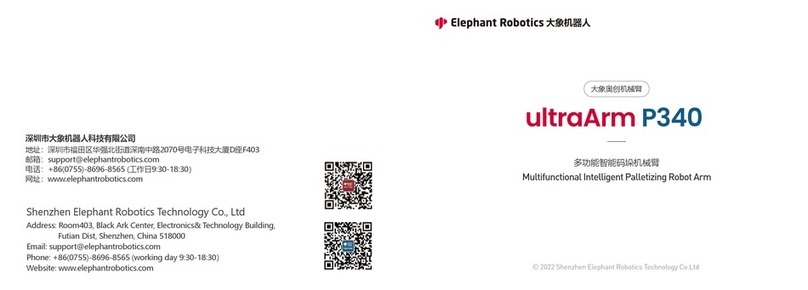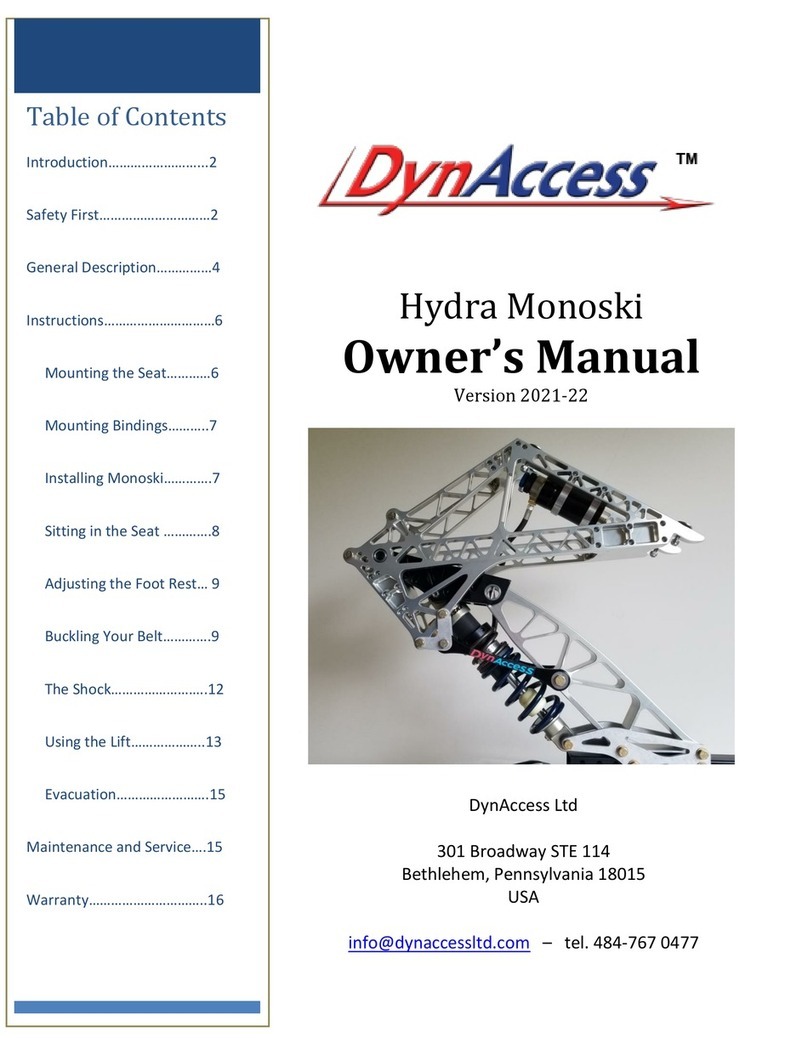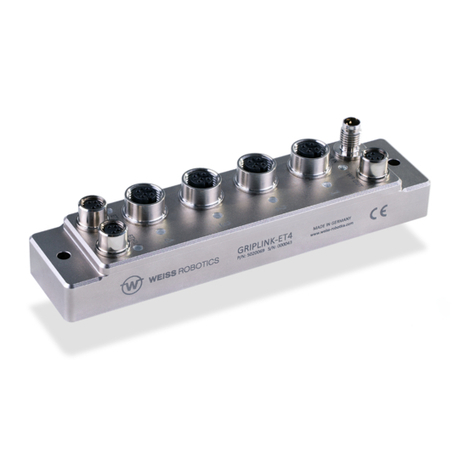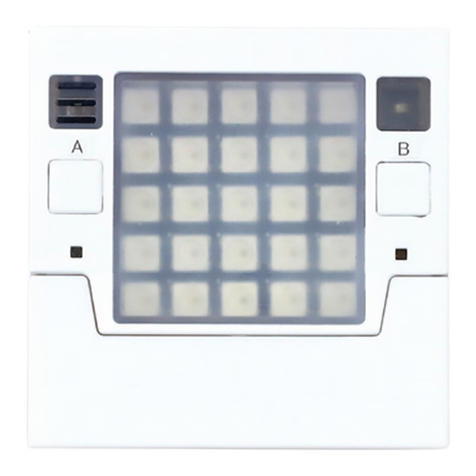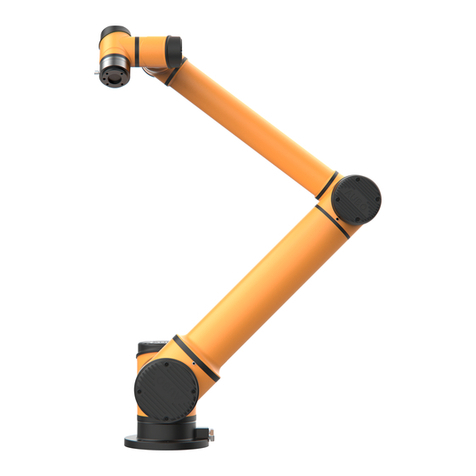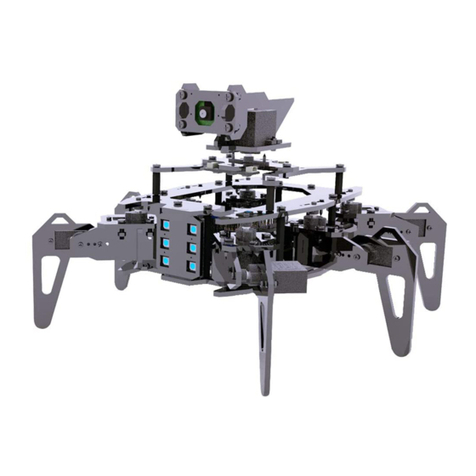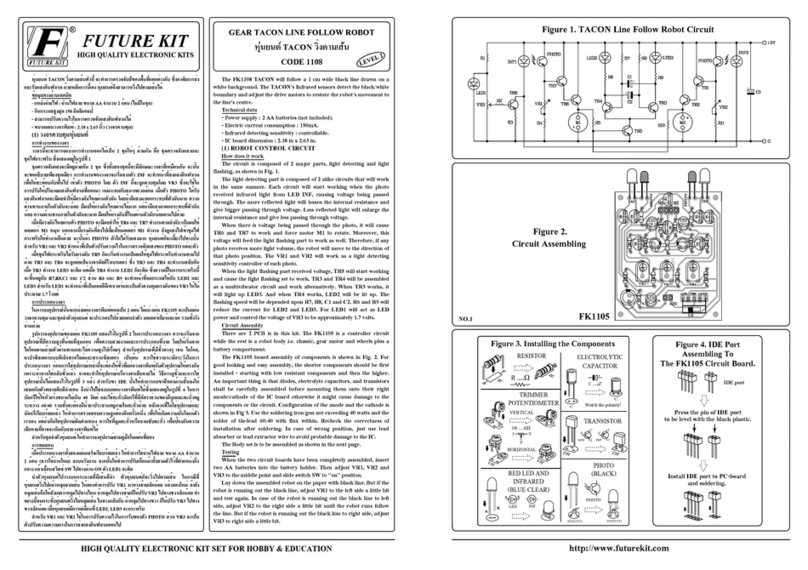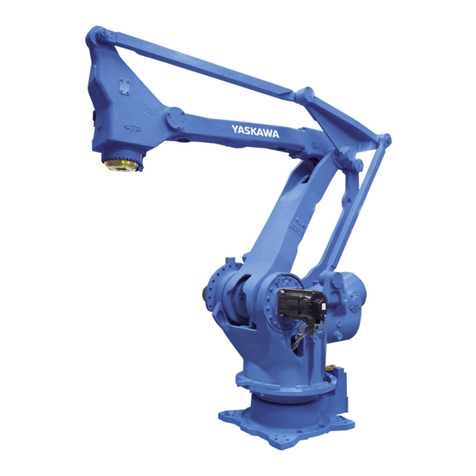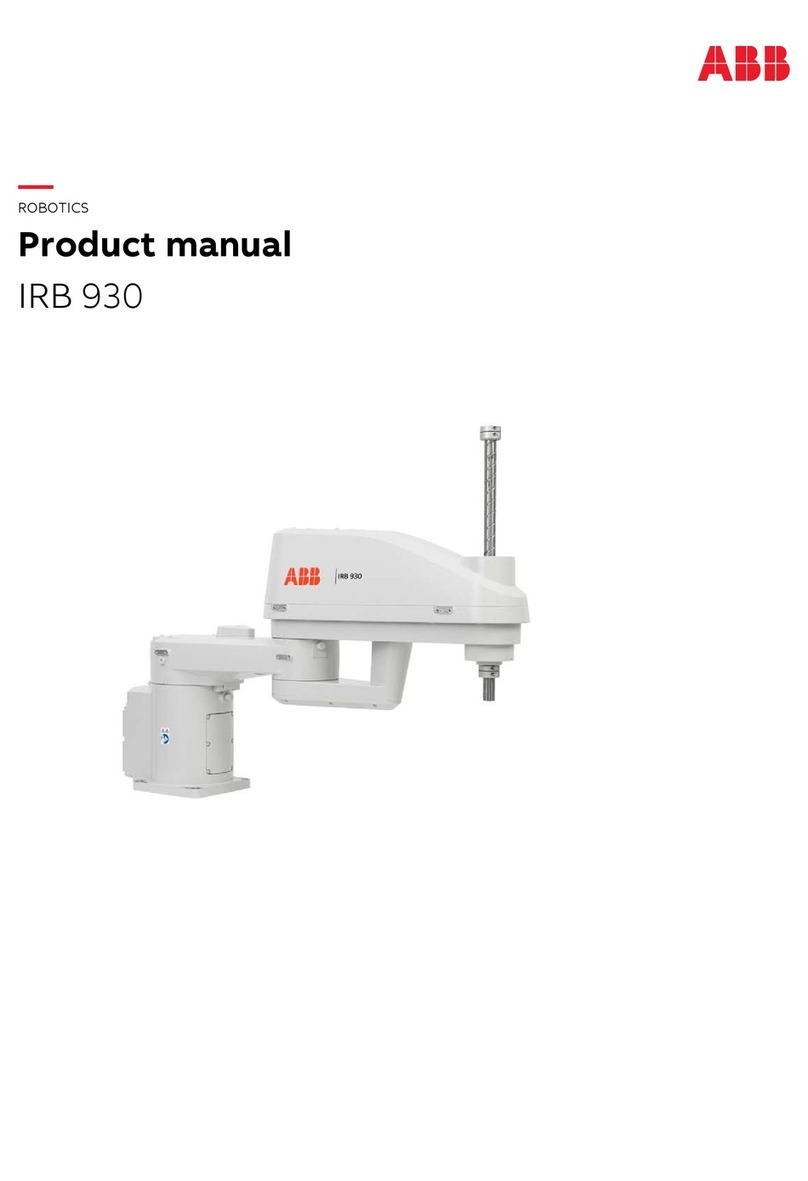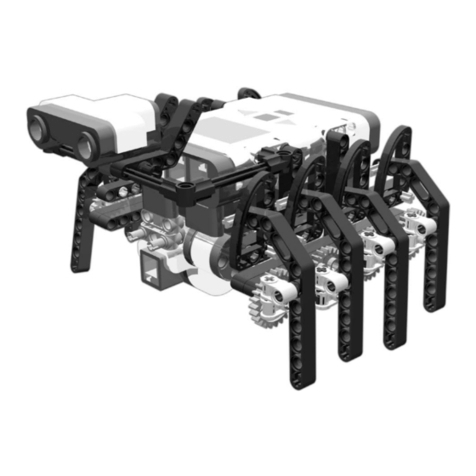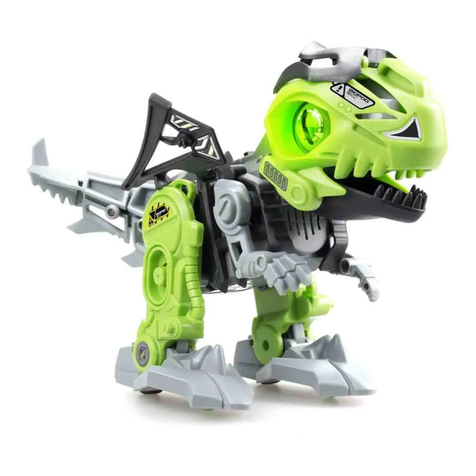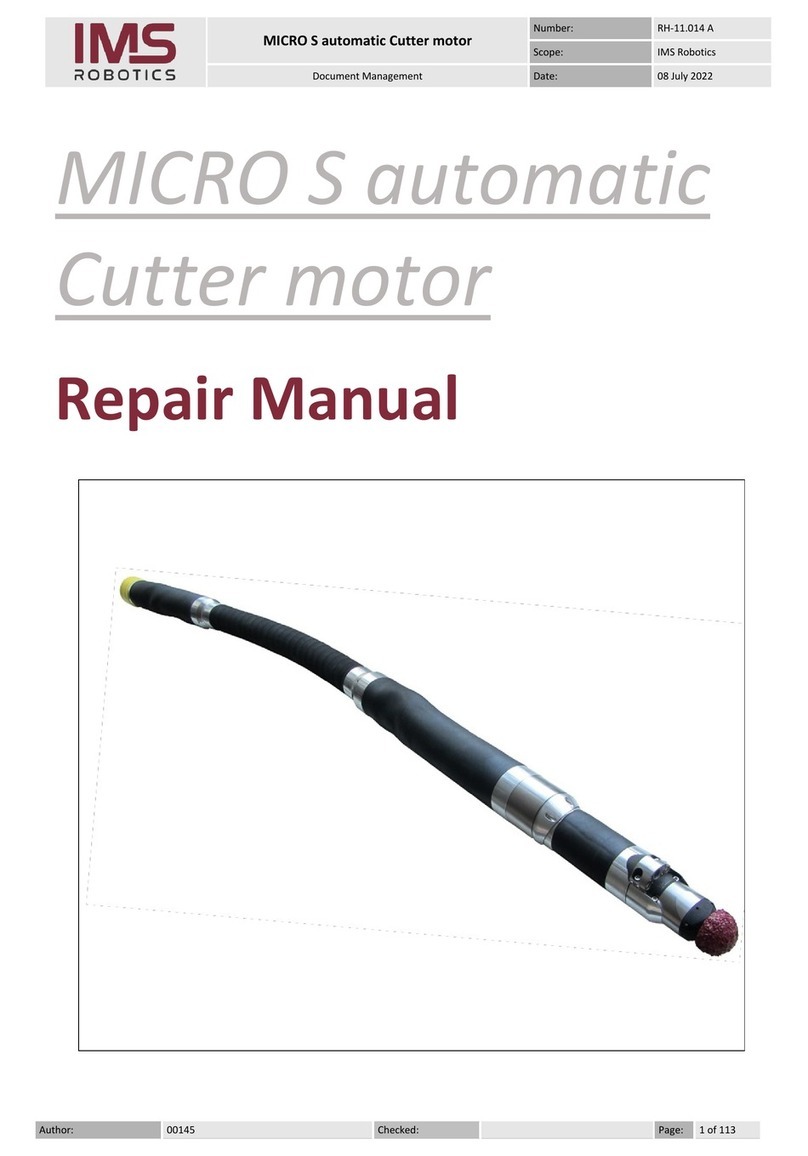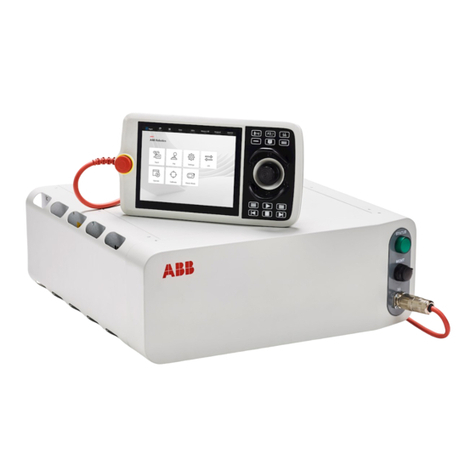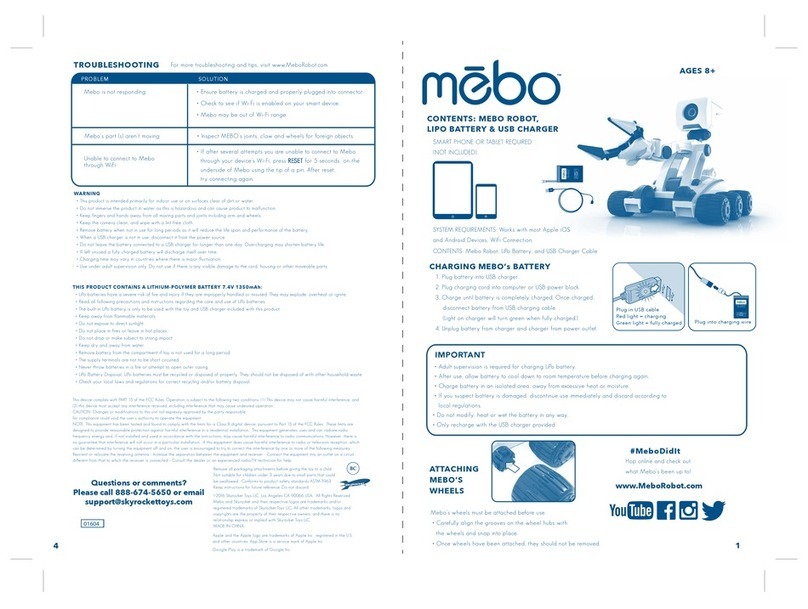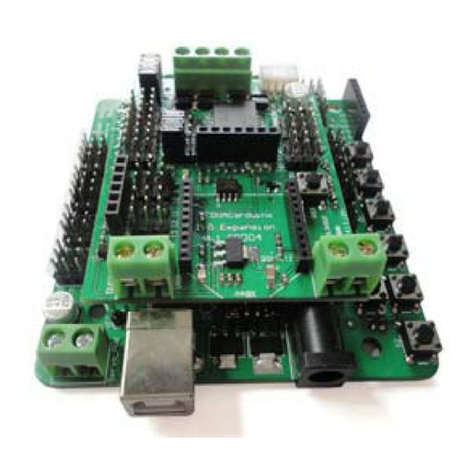Elephant Robotics Catbot Series User manual

Shenzhen Elephant Robotics Technology Co., Ltd.
Elephant Robotics
User Manual
Catbot Series Collaborative Robot
Language: English
Version: CR0919001

Shenzhen Elephant Robotics Technology Co., Ltd.
Copyright Declaration
No unit or individual may extract, compose, translate or reproduce any of the
contents of this manual without the written permission of Shenzhen Elephant
Robotics Technology Co., Ltd. (the rest of the article is referred to as “Elephant
Robotics”), and shall not in any form (including But not limited to information and
publications).
In addition, the product information and related resources mentioned in this
manual are for reference only and the contents are subject to change without
notice.
Except as expressly stated in this manual, nothing in this manual should be
construed as any warranty or guarantee by the Elephant Robotics of personal
loss, damage to property, or fitness for a particular purpose.
All rights reserved!
© Copyright 2017-2019 Shenzhen Elephant Robotics Technology Co., Ltd.
All rights reserved.

Shenzhen Elephant Robotics Technology Co., Ltd.
Catalog
Overview to the manual ...........................................................................................................1
About the manual ............................................................................................................1
Reading objects of the manual ........................................................................................1
How to use.......................................................................................................................1
Main contents of the manual ...........................................................................................1
Before the official reading of the manual .........................................................................2
1 Safety....................................................................................................................................3
1.1 Introduction.................................................................................................................3
1.2 Safety alert symbol description...................................................................................3
1.3 Hazard identification ...................................................................................................4
1.4 Safety Precautions .....................................................................................................6
1.5 Nameplate introduction...............................................................................................8
1.6 Avoid misuse ..............................................................................................................8
1.7 Risk assessment guidance.........................................................................................9
1.8 Robot stop function.....................................................................................................9
1.8.1 Emergency stop ...............................................................................................9
1.8.2 Collision detection ..........................................................................................10
1.9 Urgent handling ........................................................................................................11
2 Product description .............................................................................................................12
2.1 Robot system overview ............................................................................................12
2.2 The robot body .........................................................................................................13
2.2.1 Feature ...........................................................................................................13
2.2.2 Joint introduction ............................................................................................14
2.2.3 Dimensions.....................................................................................................14
2.2.4 Working range ................................................................................................15
2.2.5 Payload ..........................................................................................................16
2.3 The power box..........................................................................................................16
2.3.1 Power box composition ..................................................................................16
2.3.2 Power box function.........................................................................................16
2.3.3 Power box size ...............................................................................................17
2.4 Technical parameter table ........................................................................................17
3 Environment and installation...............................................................................................20
3.1 Transportation and storage ......................................................................................20
3.2 Unpacking inspection ...............................................................................................20
3.3 Working environment and conditions .......................................................................22
3.4 Mechanical connection .............................................................................................23
3.4.1 Installation requirements ................................................................................23
3.4.2 Mechanical connection step ...........................................................................23
3.5 Electrical connections...............................................................................................26
3.5.1 Electrical interface introduction ......................................................................26
3.5.2 Cable connection............................................................................................34
3.6 System startup debugging........................................................................................35
4 Maintenance .......................................................................................................................37
4.1 About the safety of maintenance ..............................................................................37
4.2 Maintenance plan .....................................................................................................38
4.3 People who can be contacted ..................................................................................38
5 Repair .................................................................................................................................40

Shenzhen Elephant Robotics Technology Co., Ltd.
1
Overview to the manual
About the manual
Welcome to use Catbot series collaborative robot and thanks for your
purchase.
This manual describes how to properly install and use the Catbot series
collaborative robot, as well as matters needing attention.
Please read this manual and other related manuals carefully before installing
this robot system. After reading, please keep it in a safe place so that you can
access it at any time.
Reading objects of the manual
This manual is targeted to:
l Installer.
l Debugger.
l Maintenance staff.
Those who perform installation/debug/repair work on the Catbot
series collaborative robot must be trained in Elephant Robotics and
have the mechanical and electrical knowledge required for the above
work.
How to use
This manual should be used when doing the followings:
l Installation work: Move the robot to the working position and fix it to the
base according to the installation instructions, place the other parts in
the proper position and complete the electrical connection.
l Debugging work: Debug the robot to work.
l Maintenance work: Regularly maintain the robot system to ensure its
can function properly; when the robot malfunctions due to
environmental influences or improper operation of the user, or a certain
component of the robot system exceeds the normal service life, etc. The
robot needs to be repaired.
Main contents of the manual
l Precautions for safe use of the robot.
l Mechanical, electrical installation and commissioning of the robot.
l Maintenance and repair of the robot.

Shenzhen Elephant Robotics Technology Co., Ltd.
2
Before the official reading of the manual
Before you officially read the manual, you need to know:
1, About robots
The Catbot series collaborative robot is different from the traditional
industrial robot, which completes the perfect slimming of the robot and realizes
the cabinet integration. It can work safely with workers and independently
complete the processes of loading, unloading, testing, checking and packaging in
industrial manufacturing.
2, About product warranty
During the warranty period of the delivered product, the company only
repairs the faults that occur when the robot is used normally. However, in the
following cases, the customer will be charged for repairs (even during the
warranty period):
1) Damage or malfunction caused by incorrect use of the contents of the
manual and improper use.
2) Failure caused by unauthorized removal by the customer.
3) Damage caused by improper adjustment or unauthorized repair.
4) Damage caused by natural disasters such as earthquakes and floods.
Therefore, please operate the robot in strict accordance with the
instructions in this manual and related manuals.
3, About help
For any questions or suggestions on the contents of the manual, you can
query on the official website of the Elephant Robotics to submit the relevant
information: https://www.elephantrobotics.com.
4, Contact information
1) Full name of company: Shenzhen Elephant Robotics Technology Co.,
Ltd.
2) Address: R208, B7, Yungu Innovative Industrial Park 2, Nanshan,
Shenzhen, China 518057
3) Mail:
l [Business Cooperation] [email protected]
l [Promotional Cooperation] [email protected]
l [Customer Service] [email protected]
l [Technical Support] [email protected]
4) Tel: +86 755 8696 8565

Shenzhen Elephant Robotics Technology Co., Ltd.
3
1 Safety
1.1 Introduction
1, Introduction to this chapter
This chapter details general safety information for those who perform
installation, maintenance, and repair work on the robot. Please read and
understand the contents and precautions of this chapter before handling,
installation and use.
According to ISO 10218, both robot manufacturers, system integrators, and
individual users must perform hazard identification and risk assessment before
using the robot. Conducting a hazard analysis can predict any hazards that may
arise; and for hazards predicted in hazard identification, a risk assessment
should be conducted to maximize personal safety and property safety.
This chapter provides a basic guide to safe use by introducing different
safety alert symbols and precautions.
2, Interpretation of related terms
1) Collaborative operation
A specially designed robot that works directly with people in a defined
workspace.
2) Collaborative workspace
In the safety protection space of the robot work unit, the robot and the
person can complete the task at the same time in the production activity.
1.2 Safety alert symbol description
As shown in Table 1-1, this section describes the safety alert symbols used
in this manual. You can find the corresponding symbols described in this chapter
in other chapters, please note the meanings of these symbols.
Table1- 1 Safety Warning Symbol Table
Danger: Refers to a situation that is about to cause danger.
Failure to avoid this can result in death or serious injury.

Shenzhen Elephant Robotics Technology Co., Ltd.
4
Warning: Refers to situations that may cause danger. Failure to
do so can result in personal injury or serious damage to the
equipment.
Caution Electricity: Refers to the use of electricity that may
cause danger. If this situation is not avoided, it may result in
personal injury or serious damage to the equipment.
Prohibited: Refers to things that are not allowed to do.
Attention: Refers to important matters that need attention.
1.3 Hazard identification
The safety of collaborative robots is based on the premise of proper
configuration and use of robots. Also, even if all safety instructions are observed,
injury or damage caused by the operator may still occur. Therefore, it is
important to understand the safety hazards of the use of robots, which is
beneficial to prevent problems.
Tables 1-2~4 belowed are common safety hazards that may exist in the
context of using robots:
Table1- 2 Dangerous safety hazards
1
Personal injury or robot damage caused by incorrect operation during robot
handling.
2
The robot was not fixed as required. For example, if the screw is not
screwed or tightened, and the base is insufficient to stably support the
robot for high-speed movement, etc., the robot may be dumped, etc.,

Shenzhen Elephant Robotics Technology Co., Ltd.
5
resulting in personal injury or damage to the robot.
3
The correct safety function configuration of the robot is not performed, or
the safety protection tools are not installed, which causes the robot to fail
to function safely, thus causing danger.
Table1- 3 Warning level security risks
1
Do not stay within the robot's range of motion when debugging the
program. Unsuitable safety configurations may not avoid collisions that
could cause personal injury.
2
Connecting robots to other equipment can create new risks and require a
full risk assessment.
3
Scratches and stabs caused by sharp surfaces such as other equipment in
the work environment or robot end effectors.
4
The robot is a precise machine, and pedaling may cause damage to the
robot.
5
It is dangerous to hold the clamped object without clamping it in place or
turning off the power and air supply to the robot (not sure if the end
effector is firmly holding the object without falling off due to loss of power).
It is dangerous to hold the clamped object without clamping it in place or
turning off the power and air supply to the robot (not sure if the end
effector is firmly holding the object without falling off due to loss of power).
6
There is a risk that the robot will move unexpectedly. Under no
circumstances should you stand under any axis of the robot!
7
The robot is a precise machine. If it is not placed smoothly during handling,
it may cause vibration and may cause damage to the internal components
of the robot.
8
Compared with ordinary mechanical equipment, robots have more freedom
and more range of motion. A narrow space that does not meet the range of
motion may cause an unexpected collision.
Table1- 4 Potential safety hazards that may result in electric shock
1
Using a non-original cable may pose an unknown hazard.

Shenzhen Elephant Robotics Technology Co., Ltd.
6
2
Exposure to liquids with electrical equipment can result in a risk of
electrical leakage.
3
There may be an electric shock hazard when the electrical connection is
incorrect.
4
Be sure to replace it after turning off the power to the controller and
related equipment and unplugging the power cord. If the work is performed
while the power is on, it may cause electric shock or malfunction.
1.4 Safety Precautions
In general, compared with ordinary machinery, robots have the
characteristics of larger working range and faster speed, which is accompanied
by the danger that ordinary machinery does not have. When installing, using, and
maintaining the robot, pay attention to the following items listed in Tables 1-5~6
(the followings are some of the common precautions listed):
Table1- 5 Safety precautions that need to be banned
1
It is forbidden to modify the robot or use non-original accessories.
2
Untrained non-professionals are prohibited from entering the robot work
area at will, pressing any button or doing other operations at will.
3
The relevant personnel shall not maintain, repair or use the robot after
being affected by drinking, taking drugs or stimulating drugs.
Table1- 6 General safety precautions
1
Anyone responsible for installing and maintaining the robot must read and
follow these safety instructions. Only those who are familiar with robots
and trained in robots are allowed to install and maintain the robot.
2
To protect the programmer, the operator, and the bystander, ensure that
the safety measures have been established as defined in the risk
assessment and that the robot safety parameters are properly configured.
3
Production operators should not loosen long hair (long hair must be picked

Shenzhen Elephant Robotics Technology Co., Ltd.
7
up) and wear a work cap, not wearing a variety of jewelry.
4
Operators who work with the robot must be familiar with the content and
exact location of the various warning signs and symbols on the device and
ensure their integrity and clarity. Before turning the device on and off,
make sure that all safety devices and related accessories are working
properly and that no one is in a dangerous location where the device is
activated. When the robot runs abnormally, it should stop immediately and
report in time.
5
The operator must clarify the scope of responsibility for operation,
commissioning, maintenance and repair. The operator is not allowed to
change the operating procedures and teaching at will. No other personnel
may enter the collaborative operation space and the danger zone.
6
During maintenance work, the warning sign must be hung to enter the
collaborative operation space.
7
When the operator is in production, it should be ensured that each starting
device is normal and is not allowed to start at will.
8
When the maintenance and operation personnel perform maintenance on
the equipment, the main power switch must be turned off before
maintenance work can be performed.
9
No objects should be stacked in the robot working area, and no debris
should be stacked in the control box.
10
After the operation is completed, the gas and electricity switches should
be closed according to the process, and the work site should be cleaned
up.
11
It is forbidden to shake the robot hard and hang heavy objects on the
robot.
12
All dangerous behaviors or games are prohibited around the robot.
13
After installing the robot, make sure the robot is fixed on a stable surface
for subsequent operations.
14
It is important to ensure that the robot does not collide with itself or other
objects during exercise.
15
If the robot is damaged, do not continue to use it and contact the relevant
personnel for processing.
16
Please use the robot within the robot's parameter range and service life,
otherwise it may cause serious safety problems.
17
After the emergency stop state is cancelled, the servo power must be
turned on before the servo power supply is turned on again.
18
Please pay attention to the rotating shaft of the robot to prevent the cable
and the air tube from being entangled. Keep a distance from the moving
shaft to prevent hair or clothings from getting entangled.

Shenzhen Elephant Robotics Technology Co., Ltd.
8
19
Before using the drag teach function, make sure the load settings are
correct.
20
When the robot is used with other equipment, please connect the
emergency stop signal in series to stop the robot and other equipment in
an emergency to avoid unnecessary loss.
1.5 Nameplate introduction
There are two types of nameplates used in the robot system, namely the
nameplate of the robot body and the power box. The nameplate records some
basic information about the product. It should be noted that the production
number on the nameplate is unique. In other words, each product has a unique
ID, which is an important basis for distinguishing each product, and is also
important information to be provided when applying for repair.
Figure 1- 1 Robot body nameplate
Figure 1- 2 Power box nameplate
1.6 Avoid misuse
Please do not use the Catbot series collaborative robot for the following
purposes:

Shenzhen Elephant Robotics Technology Co., Ltd.
9
" Medical and life-critical applications.
" May cause an explosion in the environment.
" Used directly without risk assessment.
" Insufficient use of safety function levels.
" Inconsistent use of robot performance parameters.
1.7 Risk assessment guidance
Risk assessment is the whole process including risk analysis and risk
assessment. National laws require risk assessment. It is recommended that
integrators apply ISO 12000 and ISO 10218-2 for risk assessment of robots.
The risk analysis mainly includes:
" Determination of various limitations of the robot, including usage
restrictions, space restrictions, and the like.
" Hazard identification, in addition to some of the hazard identification
items listed above, users also need to carry out hazard identification
according to actual use. For example, human-machine interactions
during the life of the machine, possible states of the machine,
unintended operator conditioning behaviors, or misuses that the
machine can reasonably foresee.
" Risk estimation, analysis of risk factors (such as severity of injury,
probability of injury, etc.), estimation of exposed personnel, protective
measures, etc.
After completing the risk analysis, a risk assessment should be conducted to
determine if a risk reduction is required.
1.8 Robot stop function
Each robot should have a protective stop function and a separate emergency
stop function. This section describes two ways to stop the robot:
" If you want to stop the robot in an emergency, immediately press the
emergency stop switch.
" When the force generated by the collision of the robot with the person
or object is greater than the set threshold, the robot detects the force
generated by the collision and stops or moves to a certain position
(collision return).
1.8.1 Emergency stop
An emergency stop will cut off the drive source of the robot drive. At the
same time, the hold-type brake will stop the inertial motion of the robot, the
robot will stop all movements, and the running program will be stopped.
Do not press the emergency stop switch at will during normal operation. If
the emergency stop switch is pressed during the action, the trajectory of the

Shenzhen Elephant Robotics Technology Co., Ltd.
10
robot before stopping will be different from the trajectory during normal
operation, which may trigger an accident such as a collision.
When the vehicle is in an emergency stop state (normal), if the robot system
is to be placed in an emergency stop state, press the emergency stop button
when the robot does not operate.
Before using the emergency stop switch, you need to know the following:
" The emergency stop (E-STOP) can only be used to stop the robot in very
urgent situations.
" The Catbot series collaborative robot has set up multiple emergency
stops. In addition to the power box emergency stop button and the
external emergency stop interface of the power supply box, an
emergency stop interface is also provided on the robot body, and an
emergency stop button box or a teach pendant can be connected
(optional, the teach pendant is provided with an emergency stop
button).
" The emergency stop button can only be manually reset, and before
resetting, it is necessary to confirm that any other hazards that can be
controlled by the robot have been eliminated.
" To stop the robot from running in a non-emergency situation, use the
Pause command or the Stop command. These two commands do not
turn off the motor. Therefore, the brake will not work.
" If you need to control the emergency stop of the robot and other
equipment at the same time, you can use the external E-STOP double
loop circuit (you need to short the circuit when it is not in use). This is a
protective stop circuit that can be controlled manually or automatically.
1.8.2 Collision detection
During the operation of the robot, it is possible to come into contact with
people or objects. It can be protected by setting a protection threshold. The
specific mechanism of action is as follows: When the force generated by the
collision of the robot with the person or the object is greater than the threshold,
the robot detects the force generated by the collision, thereby stopping or moving
to a certain position (collision return).
Please note that when the protection threshold is set too high, a large force
is required to stop the robot, which will reduce the sensitivity of the collision
detection to a certain extent; When the protection threshold is set too low, the
robot may stop when it is holding the load due to the excessive torque generated
by its own motion. Therefore, please set the threshold of protection under the
guidance.
In addition to this, the user can set the protection threshold for each action
and each movement of the robot.

Shenzhen Elephant Robotics Technology Co., Ltd.
11
1.9 Urgent handling
If the software jumps out of a fatal error message, activate the
emergency stop quickly, write down the condition that caused the
error, and contact your supplier.
In the event of a fire, use a carbon dioxide (CO2) fire extinguisher!

Shenzhen Elephant Robotics Technology Co., Ltd.
12
2 Product description
2.1 Robot system overview
The Catbot series collaborative robot is a 6-axis robot designed for business
and education.
Generally, a traditional robot consists of three major parts: a robot body, a
teach pendant, and a controller. As shown in Figure 2-1, the Catbot series
collaborative robot use the latest integrated design. It solves the problem that the
robot controller needs another land occupation for the first time and integrates
the controller into the robot body to perfectly realize the cabinet integration. On
the basis of accomplishing the same function, the advantages of convenient
carrying, reducing space limitation and flexible arrangement are added.
1- Robot body
2-Power box
3-Teach pendant(optional)
Figure 2- 1 Robot system
1, The robot body
The robot body is a mechanical body used to complete various tasks of the
robot system. It mainly includes the robot shell, drive unit, transmission unit and
internal sensors. The main robot shell material is aluminum.
The robot's principle of motion is a combination of rotational motions of six
joints. Using kinematics and dynamics analysis, the algorithm is solved to
achieve the desired motion at the end of the robot.
The Catbot series collaborative robot also integrates the controller into the
body. The controller is the main body that completes the robot control function
and is a key part of determining the function and level of the robot. The main
component is the computer, which controls the overall motion of the robot.
2, The power box
A power box is used to power the robot body. It also sets an emergency stop
button for user-friendly use.
3, The teach pendant(optional)

Shenzhen Elephant Robotics Technology Co., Ltd.
13
The teach pendant is the main interface of human-computer interaction, and
its internal part is composed of a touch screen, a display, a driving circuit board
and some components. The robot can be programmed and operated by using a
teach pendant.
In the Catbot series collaborative robot, the teach pendant is an optional
accessory. Even without the teach pendant, the user can connect to the robot
using other display devices, tablets, mobile phones, etc., to achieve related
operations on the robot.
To put it simply, if the robot system is like a human, then the controller is like
a human brain, controlling the robot body (like a human hand) to perform tasks,
and the teach pendant is a human-computer interaction interface between the
robot system and people.
2.2 The robot body
2.2.1 Feature
The Catbot series collaborative robot has the advantages of convenient
carrying, easy installation, short deployment time, easy operation, safe use and
convenient expansion of peripheral equipment, which can greatly shorten the
deployment time of the factory for automation project transformation and reduce
the total cost of deployment. The specific description is as follows:
1, Cabinet integration
The Catbot series collaborative robot integrates the controller into the robot
body to achieve cabinet integration. It has a modular design and a compact body
with a body weight of only 18kg. This design also greatly reduces the overall
footprint of the robot system, and can effectively simplify the installation steps of
the robot and shorten the installation time.
The Catbot series collaborative robot can adapt to the structure of the
production workshop, but also to the installation conditions of shops and studios
in non-industrial environments.
2, Voice control
In addition to the unique security of collaborative robots, the genie series of
collaborative robots also added human-machine voice interaction. This is also a
manifestation of the development of robotic AI, making the machine interaction
more diversified. The user can directly talk to the robot, easily know the current
running state of the robot, and use the voice command to control the robot to
start or pause the running of the program, making the robot more convenient and
efficient.
3, Security collaboration
Based on the accurate kinetic model of the collision detection algorithm, the
Catbot series collaborative robot will automatically stop in case of a slight

Shenzhen Elephant Robotics Technology Co., Ltd.
14
collision to ensure the safety of personnel. Users do not need to set a safety
fence when using the Catbot series collaborative robot, which can be easily
applied to light industry, commercial, scientific research and other occasions.
2.2.2 Joint introduction
Figure 2-2 shows the schematic diagram of the joint number of the Catbot
series collaborative robot. The Catbot series collaborative robot is a 6-degree-of-
freedom industrial robot consisting of six joints (axes) with joint numbers as
shown.
The robot body of the Catbot series collaborative robot can be regarded as
an open chain multi-link mechanism. The starting link is the base of the robot,
the end link is connected to the end effector, and the adjacent links are
connected by a joint (axis).
Figure 2- 2 Robot body joint numbering diagram
The flange at J6 can be used to connect end effectors such as electric
actuators or end effectors such as pneumatic suction cups.
2.2.3 Dimensions
Figure 2-3 shows the outline of the robot body.

Shenzhen Elephant Robotics Technology Co., Ltd.
15
Figure 2- 3 Robot outline drawing
The span is the straight-line distance between the farthest point that the
robot's wrist can reach and the centerline of the robot's base when the arm is
extended horizontally to the maximum extent. The arm of the Catbot series
collaborative robot is about 600mm.
2.2.4 Working range
Figure 2-4 shows the workspace of the Catbot series collaborative robot.
Please limit the actual range of the robot according to the range of motion of the
robot before using the robot to avoid the consequences of mismatch between the
span and the actual motion space.

Shenzhen Elephant Robotics Technology Co., Ltd.
16
Figure 2- 4 Robot workspace diagram
2.2.5 Payload
The Catbot series collaborative robot has a rated load of 3kg and can work
normally under load of 3kg and below. As the load moves further and further
away from the J6 flange position, its payload will become smaller and smaller.
2.3 The power box
2.3.1 Power box composition
The main components of the power box are the switching power supply, the
safety relay and the interface and buttons on the outside of the power box
housing, as well as two handles and four foot cups.
2.3.2 Power box function
The main functions of the power supply box of the Catbot series
collaborative robot are the safety function, the power supply function of the on-
off body and the third-party power supply connection function.
1, Safety features
The main electrical components in the power box that are closely related to
safety functions are safety relays and emergency stop buttons.
The safety function mainly includes the user can cut off the power of the
motor driver through the emergency stop button in an emergency; Once the
emergency stop state is reached, after the emergency or related fault is removed,
the user needs to manually reset the emergency stop button, and also needs to
restore the motor driver power supply through software reset.
2, On-off robot body power function
Make sure that the electrical connection is correct, the emergency stop
button is released (ie, it has not been pressed, if it has been pressed, it can be
turned clockwise), and the external emergency stop double circuit has been
shorted, the user plugs the power boxʼs plug into the socket. By turning on the

Shenzhen Elephant Robotics Technology Co., Ltd.
17
power button on the power box, the robot body can be successfully supplied with
a safe voltage of DC 48V or less.
Reverse operation can cut off power to the robot body.
3, Third-party power transfer function
In some usage scenarios, the robot body does not require a power supply
box to directly supply power, and only needs to be powered from other devices.
For example, when the robot body is mounted on an AGV car, the user only needs
to take power directly from the AGV car to supply power to the robot. Therefore,
a dedicated third-party power supply interface is available on the power box.
2.3.3 Power box size
Figure 2-5 shows the external dimensions of the power supply box. When
installing the robot, the user needs to determine the placement position by
considering the external dimensions of the power box and the length of the
power cord.
Figure 2- 5 Power box outline drawing
2.4 Technical parameter table
The specifications of the Catbot series collaborative robot are shown in
Table 2-1.
Table 2- 1 Technical parameter table
the Catbot series collaborative robot
Payload
3kg
Table of contents
Other Elephant Robotics Robotics manuals
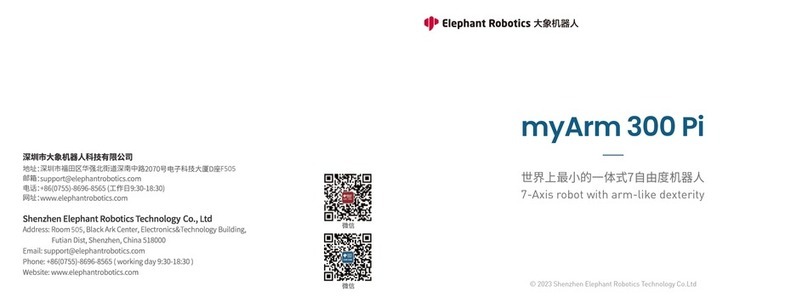
Elephant Robotics
Elephant Robotics myArm 300 Pi User manual
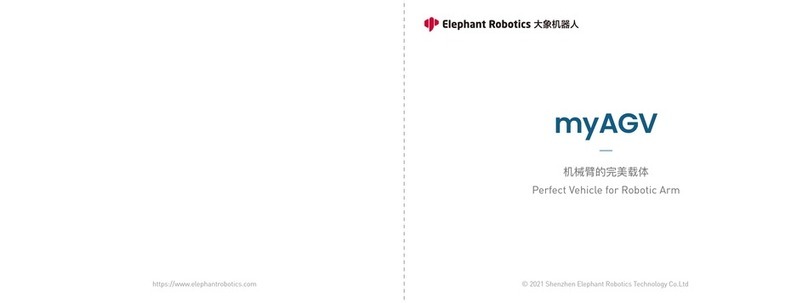
Elephant Robotics
Elephant Robotics myAGV User manual
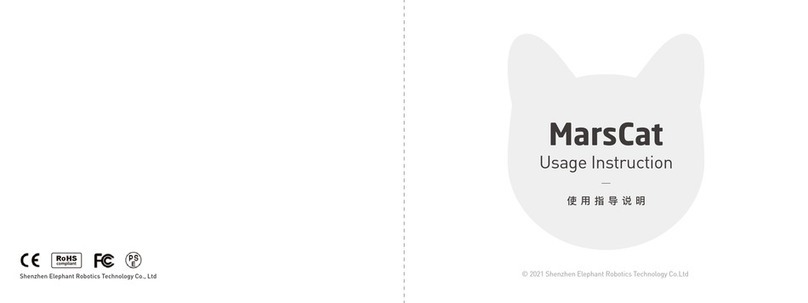
Elephant Robotics
Elephant Robotics MarsCat Parts list manual
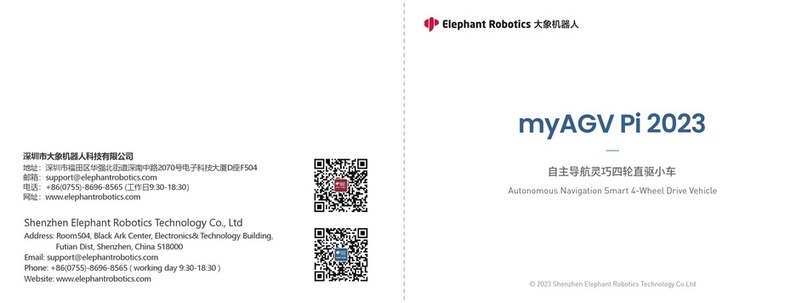
Elephant Robotics
Elephant Robotics myAGV Pi 2023 User manual
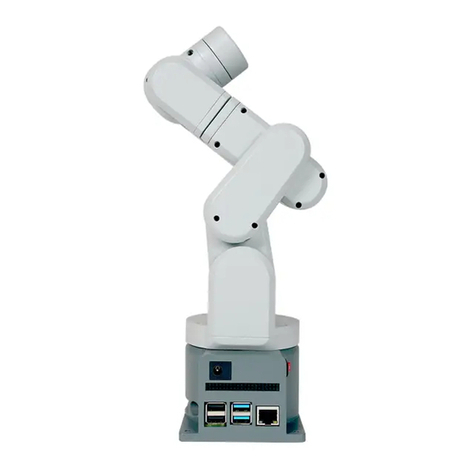
Elephant Robotics
Elephant Robotics mechArm Series User manual
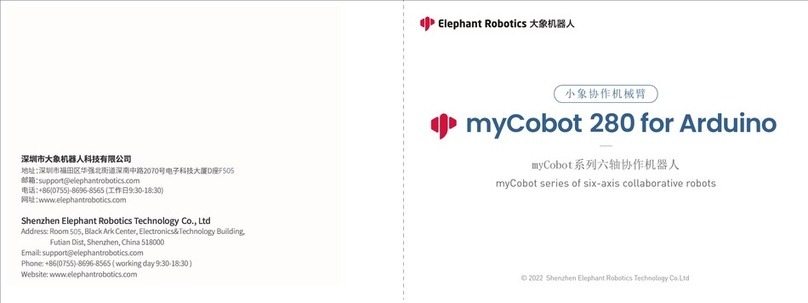
Elephant Robotics
Elephant Robotics myCobot 280 User manual

Elephant Robotics
Elephant Robotics myBuddy 280 User manual
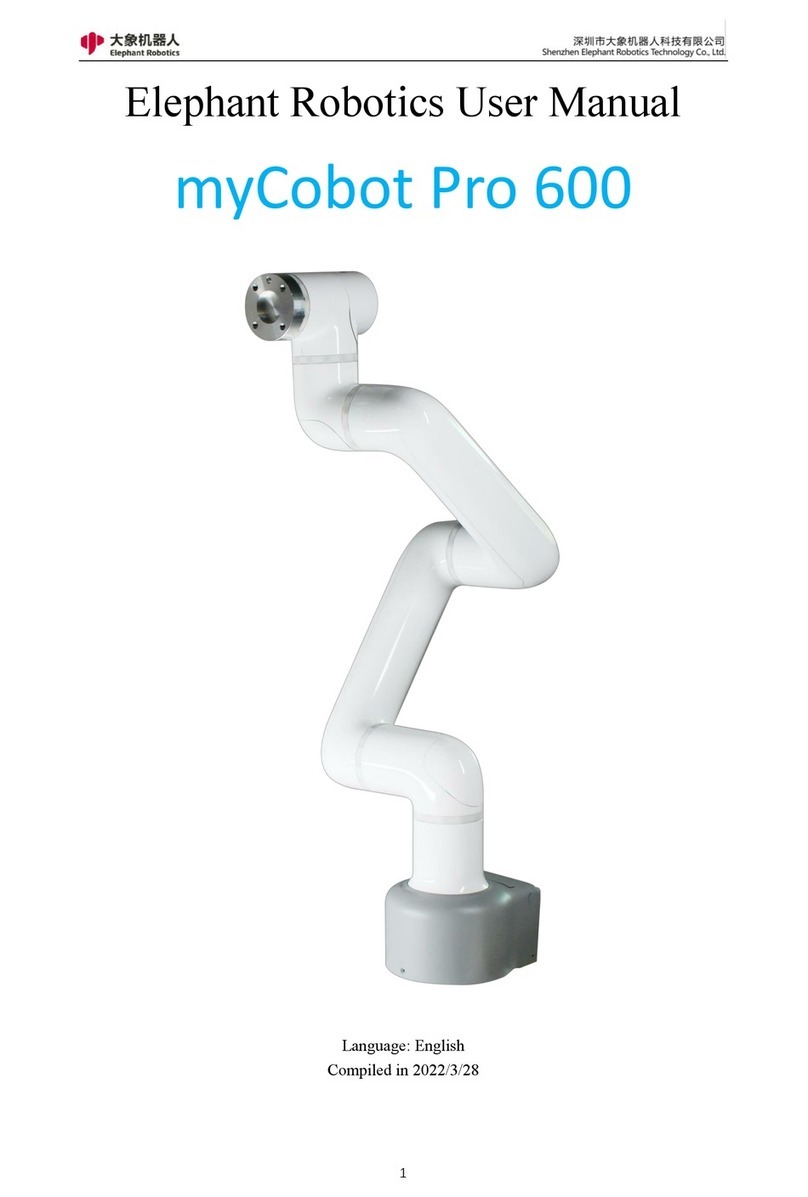
Elephant Robotics
Elephant Robotics myCobot Pro 600 User manual
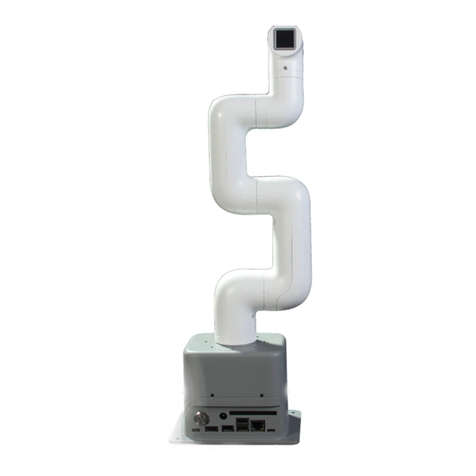
Elephant Robotics
Elephant Robotics myCobot 280 JetsonNano User manual
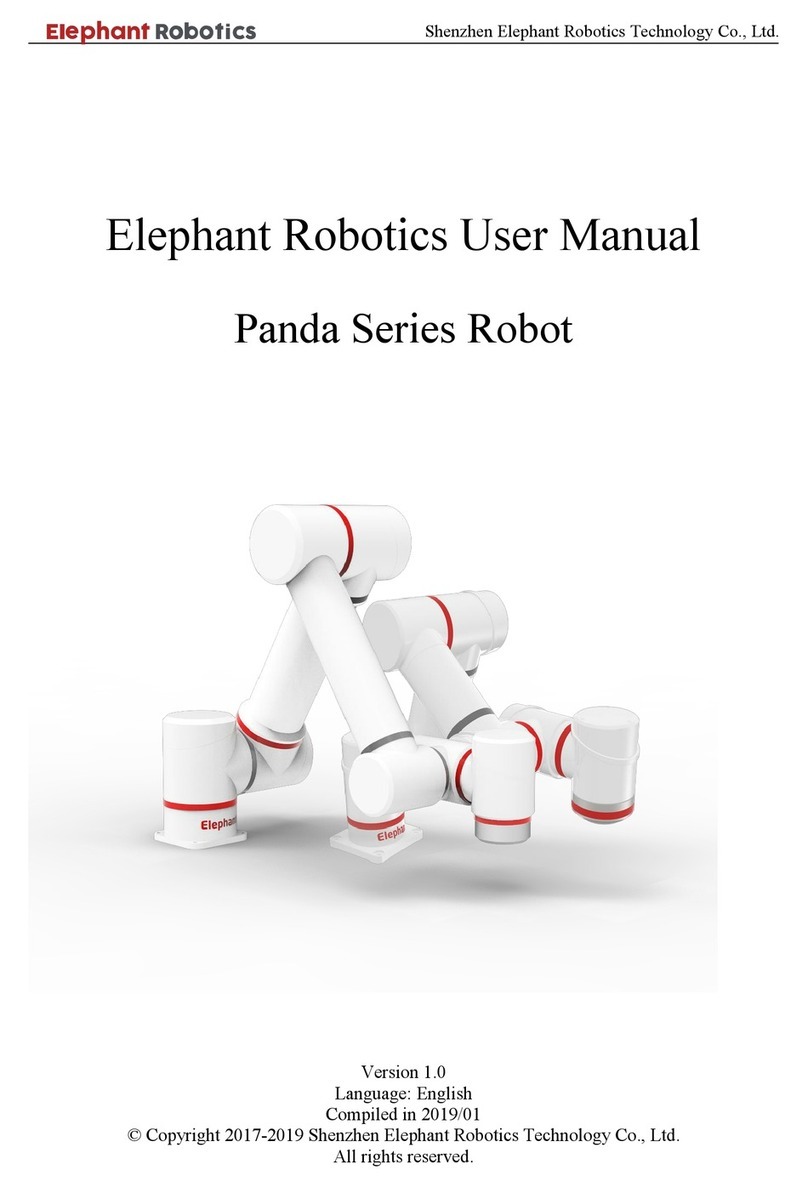
Elephant Robotics
Elephant Robotics Panda Series User manual
